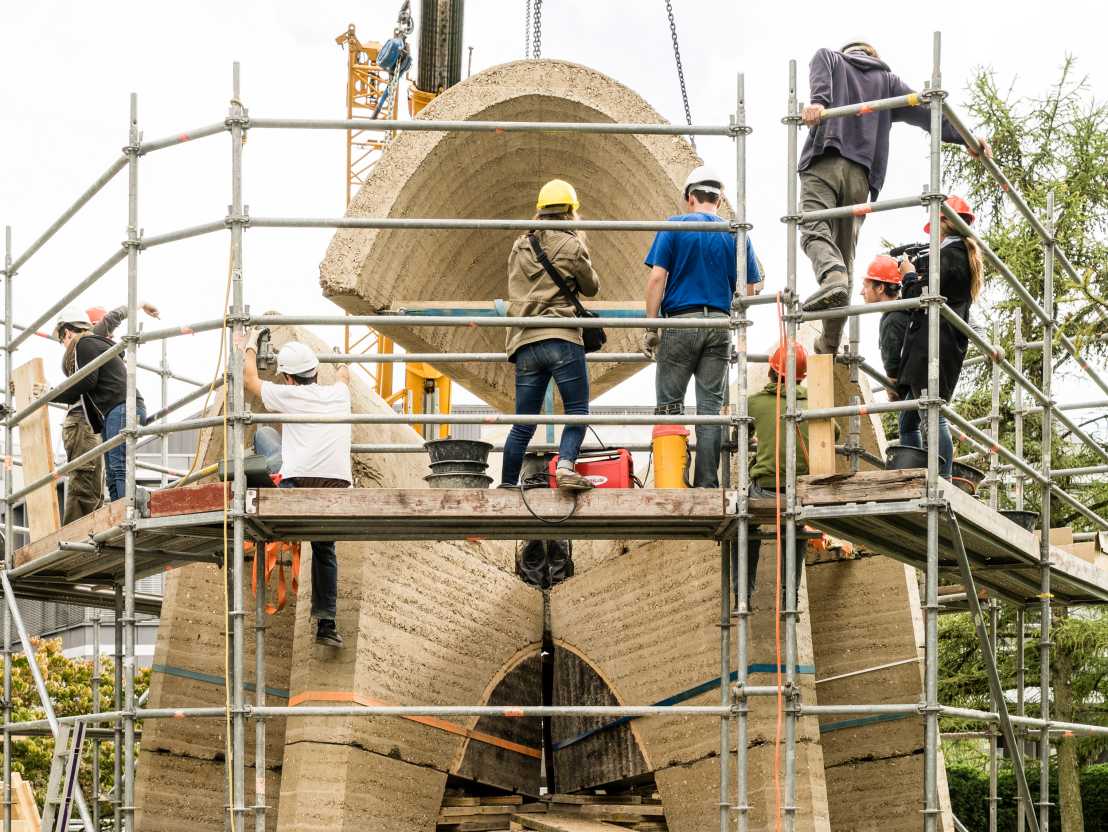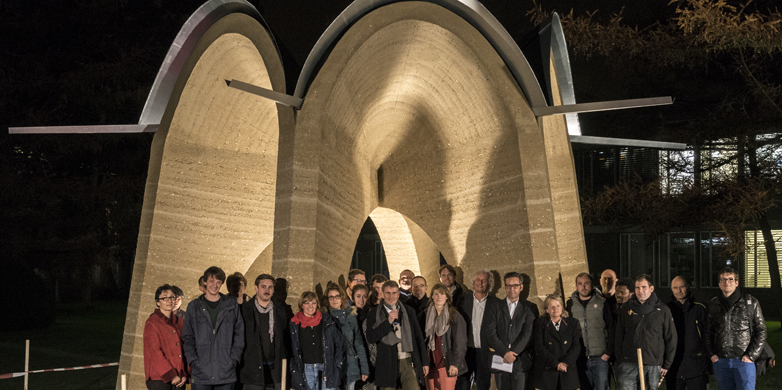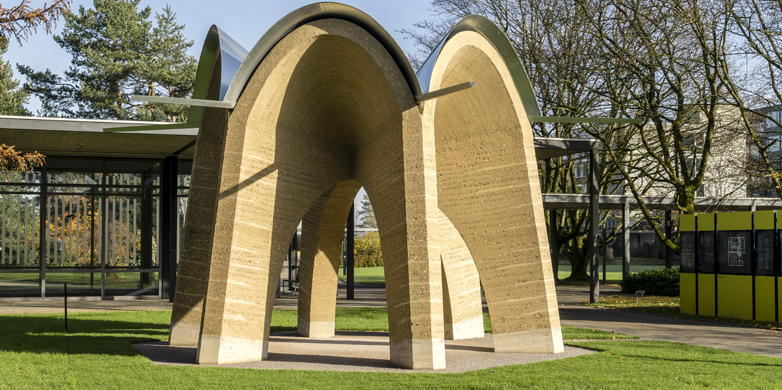Unique rammed earth dome at Hönggerberg
The ETH Hönggerberg campus has a new attraction: a dome built with prefabricated rammed earth elements that provides a sanctuary for relaxing in summer and offers new insights into the stability of earth structures. It was designed and built by students from the Department of Architecture.
Annette Spiro’s Chair of Architecture and Construction is known for hands-on teaching and in-depth exploration of building materials. They established a collection of materials for architects and civil engineers in collaboration with the ETH Baubibliothek in 2010, and in 2012 offered the optional module Material Workshop for the first time. “We want to give students the opportunity to explore building materials not only in theory, but also in practice”, says Gian Salis, a lecturer in the department who is responsible for the module.
Architecture students began studying loam as a building material in detail in spring 2012. Yesterday, they revealed the results to ETH Rector Lino Guzzella and delegates of the Department of Architecture: a five-metre-high multi-purpose shelter defined by six wide arches and six domes that open outwards. The minimalistic structure’s design concept is unique and succeeds for the first time in constructing a dome with prefabricated elements made of non-stabilised rammed earth.
Rediscovering loam
Loam is one of the oldest building materials known to humanity and was used for centuries in Africa and the Middle East to build houses, stables, mosques and palaces. It became almost forgotten with industrialisation and the prevalence of concrete, and even today it has a reputation as a transient and inferior building material. The design and construction possibilities of loam have always been severely limited: although it can withstand compressive forces, it is unable to absorb tensile forces. It also takes time to dry and harden, which makes it impossible to ram curved or vaulted shapes directly on site.
The construction of roofs or arches was previously attainable only through the use of loam bricks and mortar. “The possibility today of prefabricating rammed earth elements opens up a completely new range of applications”, says Salis. “And thanks to innovative construction methods, we can now use loam as a durable building material.” It offers various advantages over concrete: it is available almost everywhere, needs no chemicals to cure, contains virtually no grey energy, provides an excellent indoor climate, and can be dissolved in water for natural recycling.
The potential of the material in terms of construction and design was explored over the course of two seminars. After an initial group built a rammed earth wall in Austria in 2012, another 26 students working in groups of three or four developed seven different designs for a special construction: a rammed earth dome. The first models were built with loam from Hönggerberg. Martin Rauch, an expert with more than 30 years of experience in loam, stood by ready to help. Finally, a design was selected for implementation.
Ramming and assembling

During a two-week workshop supported by the ETH Innovedum fund, the students completed 19 rammed earth elements in the workshop of Rauch’s company, Lehm Ton Erde GmbH, to be assembled later as the domes and arches. Robust wood formworks were filled with layers of loam from the Laufen region, which was then compressed with pneumatic rammers. “The students learned on site how to transform their plans into reality with their own hands”, says Salis.
This summer, after a drying period of two months, the elements were assembled by the students at the Hönggerberg campus using a pneumatic crane. But the building isn’t free of all conventional materials: the foundation was prepared in advance with concrete and a metal plate protects the roof from rain. “For stability, it is essential that the core of the rammed earth building is kept dry,” says Salis. The objective of the exercise was not to banish the use of concrete completely, but to use it only where absolutely necessary.
Close contact with practical experience
During the two-week construction period, Georg Bachmann Student at the Departement of Architecture helped to assemble the rammed-earth elements weighing up to three tonnes and afterwards to plaster the joints and edges and fill the holes for the crane suspension. What fascinated the Master’s student in particular was the way in which flaws such as chipped edges could be easily touched up by applying moisture, pressing it down with loam and lightly tapping the area with a hardwood board and hammer. “One of the incredible qualities of this material is the way you can form and repair it directly,” he says. He also likes the structure of the material; the lightness and warmth of earth walls and ceilings offer a pleasant contrast to the clean and smooth surfaces of modern architecture. Bachmann considers the hands-on experience in the workshop, and later on-site, extremely valuable: “It is important that architects know how their designs are actually built. This is an aspect that is often overlooked in their training.”
Another teaching aspect is important to Salis: “We want to make the students aware of the relationship between materials, design, form and architectural expression, and hope that this will produce a young generation of innovative architects.” Furthermore, the dome will serve as a research object in the coming years, providing insight into the weathering and long-term stability of prefabricated rammed earth elements – and perhaps it will even become the new meeting place at the Hönggerberg campus.


